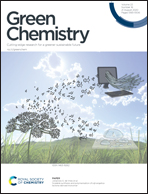Ionothermal carbonization in [Bmim][FeCl4]: an opportunity for the valorization of raw lignocellulosic agrowastes into advanced porous carbons for CO2 capture†
Abstract
In this study, we investigated the ionothermal carbonization (ITC) in 1-butyl-3-methylimidazolium tetrachloroferrate, [Bmim][FeCl4], of cocoa bean shells, a raw lignocellulosic agrowaste. The beneficial inputs of this ITC approach towards mass yield, carbon yield and specific surface area of the solid chars (namely, ionochars) were clearly evidenced. The coordination of [FeCl4]− anions to the oxygen atoms of lignocellulosic materials and ionochars seems to stabilize carbon oxygenated groups – accounting for enhanced mass and carbon yields – and to favor the generation of micropores. We showed that the use of wet starting agrowastes in the ITC process might be advantageous for the production of highly porous ionochars. Importantly, the contributions of lignin and cellulose were highlighted and the recyclability of [Bmim][FeCl4] was clearly evidenced, proving the sustainability of ITC and making this process easily applicable to other raw lignocellulosic agrowastes. The subsequent activation of the as-obtained ionochars under CO2-rich atmosphere allowed producing activated carbons with specific surface area superior to 2000 m2 g−1 and remarkable CO2 uptake as high as 4.4 mmol g−1 at 25 °C and 1 bar. This value is the highest post-combustion CO2 uptake reported to date in literature for CO2 activated biomass-derived carbons.
![Graphical abstract: Ionothermal carbonization in [Bmim][FeCl4]: an opportunity for the valorization of raw lignocellulosic agrowastes into advanced porous carbons for CO2 capture](/en/Image/Get?imageInfo.ImageType=GA&imageInfo.ImageIdentifier.ManuscriptID=D0GC01510E&imageInfo.ImageIdentifier.Year=2020)


 Please wait while we load your content...
Please wait while we load your content...